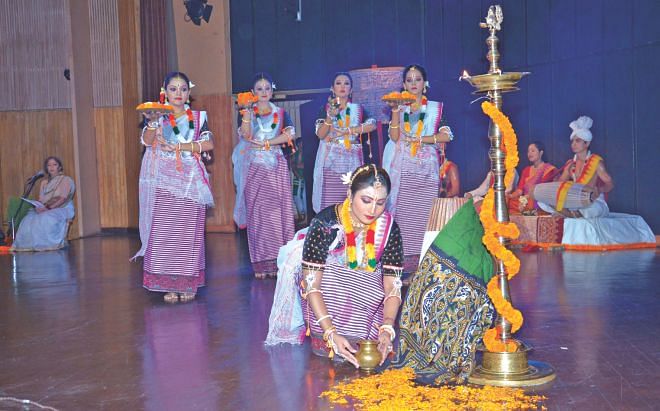Shadhona performs in Delhi

On a blisteringly hot June day in Delhi, Lubna Marium casts a critical eye at the busy stage hands and young 16-member Shadhona dancers who will stage “From Finite to Infinite” that evening at the India Habitat Centre, Delhi and “Towards Light” the following day. As the dancers clad in red T shirts do their moves, she's all attention to the questions that are fielded her way. The conversation veers from her in depth research into the origins of the Charya dance, often described as the “mother of all dance forms” in South Asia, to two-day programmes.
Excerpts from an interview that was conducted prior to the programmes:
What can the Delhi audience expect from Shadhona on this visit?
Lubna Marium: On the first day we are performing “From Finite to Infinite”. This will take the audience through a journey of spiritual performances of what is called Bangladesh from medieval times starting from the first Buddhist Charya dances that we learnt from teachers in Nepal where I did some research. Then we do the Manipuri Vaishnav dances and then we digress a bit into Tagore's devotional songs and we end up with dances on Baul music. It is an exposition of dance based on the spiritual thinking in what is now Bangladesh.
This programme is a celebration of Bangladesh.
What is “Towards Light” all about?
Lubna Marium: “Towards light” is based on excerpts of songs, poems and memoirs of Tagore. Basically we have used two writings: The first, “Awakening of the Waterfall” or Nirjherer Swapna Bhongo is a very famous Tagore poem. Tagore had a spiritual experience when he was in Calcutta. One day he got up and suddenly the whole world seemed illuminated, an experience described by many poets, including Wordsworth. After that Tagore says, he lost that vision. Within a month or so he said he went to the Himalayas but that vision never came back.
But as he grew older he wrote a beautiful song later in life which talks about the river, “Nodi Apon Bege Pagol Para”. The rivers, he says, symbolises all human beings running swiftly, trying to discover the truth, knowledge. But then Tagore says, “I am not like that. I am the still Champa tree and my journey is indescribable. It is within the stillness that I find my truth.”
We are trying to recapture Tagore mystical experiences in a narrative form.
What about Shadhona's upcoming projects?
Lubna Marium: We have a two-three year project with the Manipuris of Bangladesh where we are teaching them the nuances of Manipuri dance. The Manipuris of Sylhet and Kamolgonj know the music and the rhythm but they had forgotten their dance because of the distance from the mother country, Imphal in India.
We also have a feminist dance project. South Asian dancers are so engrossed in traditions and classicalism that reality is often missing from our performances. So I thought of this project called “Shakti” where we see issues of social justice through the perspective of feminism. First of all we started only with dancers from different parts of Bangladesh.But now we are working with target groups outside dance, like women farmers and sex workers to incorporate their issues. Within the women farmers we found some very good singers so we included them as well.
What about the new crop of dancers in Bangladesh?
Lubna Marium: We were more bothered with identities, the Muslims- Bengali dichotomy, but these kids are more willing to experiment and don't have that dichotomy at all, they are just Bangladeshis. They are willing to think beyond sectarian boundaries. It is now up to us to give them a platform and make sure that they can make a living out of music and dance. And that is what Shadhona is doing.

 For all latest news, follow The Daily Star's Google News channel.
For all latest news, follow The Daily Star's Google News channel. 



Comments